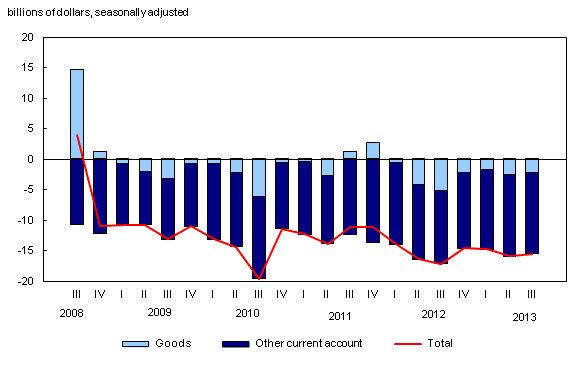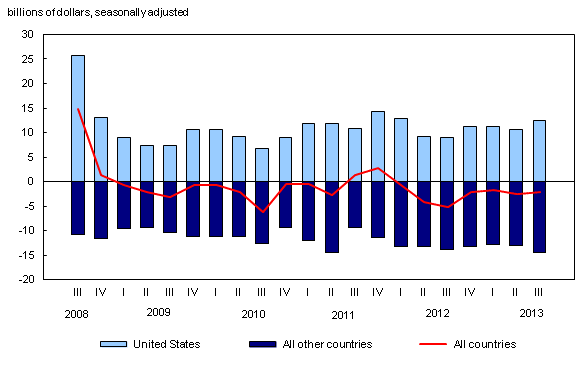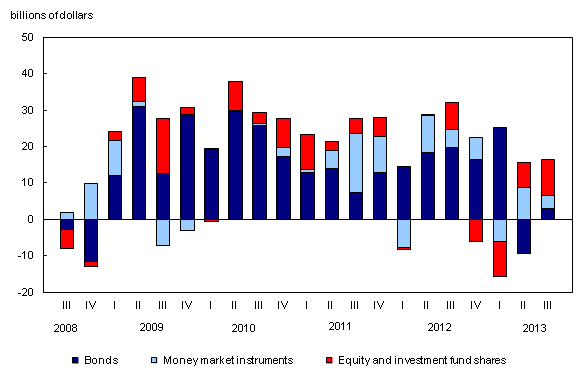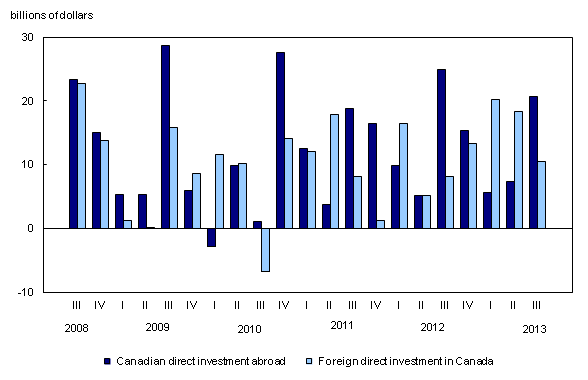Canada's balance of international payments, third quarter 2013
Archived Content
Information identified as archived is provided for reference, research or recordkeeping purposes. It is not subject to the Government of Canada Web Standards and has not been altered or updated since it was archived. Please "contact us" to request a format other than those available.
Released: 2013-11-28
Canada's current account deficit (on a seasonally adjusted basis) decreased $0.5 billion to $15.5 billion in the third quarter. This change largely reflected reduced deficits on trade in goods and services as well as on investment income flows.
In the financial account (unadjusted for seasonal variation), increased foreign investment in Canadian securities and reduced Canadian assets held abroad in the form of currency and deposits were the largest contributors to the inflows of funds in the economy.
Current account
Deficit on trade in goods reduced
The deficit on trade in goods narrowed $0.3 billion to $2.2 billion in the third quarter, as exports strengthened more than imports. The trade surplus with the United States was up $1.7 billion, largely accounted for by exports of energy and automotive products. However, the trade deficit with other countries expanded to $14.5 billion as exports were down $1.2 billion and imports were up slightly.
Overall exports of goods were up $1.4 billion to $120.1 billion, led by stronger sales of energy products. Crude oil dominated the $3.0 billion increase in energy products, mostly on higher prices, while lower natural gas exports moderated the gains in the energy account. Exports of metal and non-metallic mineral products were down $0.8 billion, reflecting lower volumes of precious metals. Higher exports of motor vehicles products were offset by lower sales of aircraft.
Total imports of goods advanced $1.1 billion to $122.3 billion. Chemical products were up $0.7 billion on higher volumes of lubricants and other petroleum refinery products. Imports of consumer goods were up $0.4 billion. Motor vehicles and parts increased $0.3 billion, as imports of parts strengthened and cars weakened. Imports of energy products were down $0.5 billion because of lower volumes of refined petroleum energy products, despite higher purchases of crude petroleum.
Lower deficit on trade in services
The overall deficit on transactions in services narrowed $0.3 billion to $5.9 billion in the third quarter. The travel deficit was reduced $0.2 billion, in line with higher spending in Canada by foreign travellers. In addition, lower imports of commercial services resulted in a slightly higher surplus in this account.
Investment income deficit shrinks
The deficit on cross border investment income flows was down $0.6 billion to $5.9 billion in the third quarter. This reflected declines in the direct investment account and gains in the portfolio account.
On the payments side, earnings of foreign direct investors in Canada fell by $0.3 billion, while interest paid to foreigners on their holdings of Canadian securities was up $0.1 billion, mainly related to corporate bonds.
On the receipt side of the ledger, earnings by Canadian direct investors declined by $0.1 billion. At the same time, dividends received by Canadian portfolio investors were up $0.2 billion.
Financial account
Foreign investment in Canadian securities focuses on equities
Foreign investment in Canadian securities increased to $16.5 billion in the third quarter, the highest such activity in a year. Non-resident investors favoured securities from the private corporate sector, mainly in the form of shares. Nevertheless, foreign investment in Canadian securities has slowed considerably in 2013 compared with levels observed in the previous four years, though the composition of this activity has evolved in recent years.
Non-resident investors acquired $10.1 billion of Canadian equities in the third quarter, the largest investment in four years. Secondary market purchases accounted for the bulk of the activity, which was mainly concentrated in September. Canadian stock prices advanced 5.4% in the third quarter, following a 4.9% decline in the second quarter.
There was $6.4 billion worth of foreign investment in Canadian debt securities in the third quarter. Non-residents increased their holdings of short- and long-term debt securities, favouring both government paper and private corporate bonds. Foreign investors injected $3.5 billion worth of funds into the Canadian money market, largely federal paper. The overall supply of these instruments was up in the quarter but at a slower pace than in the previous quarter.
Foreign investment in Canadian bonds was $2.9 billion, following a divestment in the second quarter. Non-residents added further to their holdings of private corporate bonds in the third quarter, mainly new issues denominated in foreign currencies. At the same time, they reduced their portfolio of federal government bonds for a second straight quarter, mainly reflecting retirements of these instruments.
Canadian investment in foreign stocks resumes
Canadian purchases of foreign securities were up to $5.3 billion in the third quarter. Investors acquired mainly foreign bonds as well as foreign shares, the latter following a divestment in the second quarter.
Acquisitions of foreign bonds by Canadians were $3.0 billion, marking a sixth straight quarter of such investment. This activity was all in non-US foreign bonds, as acquisitions of US corporate bonds were offset by a reduction in holdings of US government bonds in the quarter.
Canadian investment in foreign stocks amounted to $2.2 billion, following a $1.9 billion divestment in the second quarter. This included $1.7 billion of non-US foreign stocks, on par with the level of investment of the second quarter. Canadian investment in US equities resumed in the third quarter, accounting for the remainder of the activity. US stock prices were up 4.4% in the quarter, a third straight quarterly gain.
Canadian direct investment abroad strengthens
Foreign direct investment activity resulted in a net outflow of funds in the third quarter, as outward direct investment outpaced inward direct investment for the first time this year.
Canadian direct investment abroad reached $20.7 billion. This was the largest such outflow of funds in a year and was led by merger and acquisition transactions. On a geographical basis, more than half of the investment was placed in the United States.
Foreign direct investment in Canada slowed for a second straight quarter to $10.4 billion. US direct investors accounted for most of the inflows, which were widespread across most industrial groups.
Transactions in currency and deposits add to the net borrowing of funds from abroad
Transactions in the other investment categories of the financial account generated a net inflow of funds of $17.0 billion in the third quarter. Most of this activity reflected a reduction in currency and deposit assets of banks held abroad. An increase in Canada's official international reserves moderated this reduction in the quarter.
Note to readers
The balance of international payments covers all economic transactions between Canadian residents and non-residents in three accounts: the current account, the capital account and the financial account.
The current account covers transactions in goods, services, compensation of employees, investment income and secondary income (current transfers).
The current account data in this release are seasonally adjusted. For more information on seasonal adjustment, see Seasonal adjustment and identifying economic trends.
The capital account covers capital transfers and transactions in non-produced non-financial assets.
The financial account comprises transactions in financial assets and liabilities.
In principle, a net lending (+) / net borrowing (-) derived from the sum of the current and capital accounts corresponds to a net lending (+) / net borrowing (-) derived from the financial account. In practice, as data are compiled from multiple sources, this is rarely the case and gives rise to measurement error. The discrepancy (net errors and omissions) is the unobserved net inflow or outflow.
For more information about the balance of payments, consult the "Frequently asked questions" section in the National economic accounts module of our website. The module also presents the most recent balance of payments statistics.
The balance of international payments data for the fourth quarter will be released on February 27, 2014.
Contact information
For more information, contact us (toll-free 1-800-263-1136; 514-283-8300; infostats@statcan.gc.ca) or Media Relations (613-951-4636; statcan.mediahotline-ligneinfomedias.statcan@canada.ca).
To enquire about the concepts, methods or data quality of this release, contact Denis Caron (613-951-1861; denis.caron@statcan.gc.ca), International Accounts and Statistics Division.
- Date modified:





